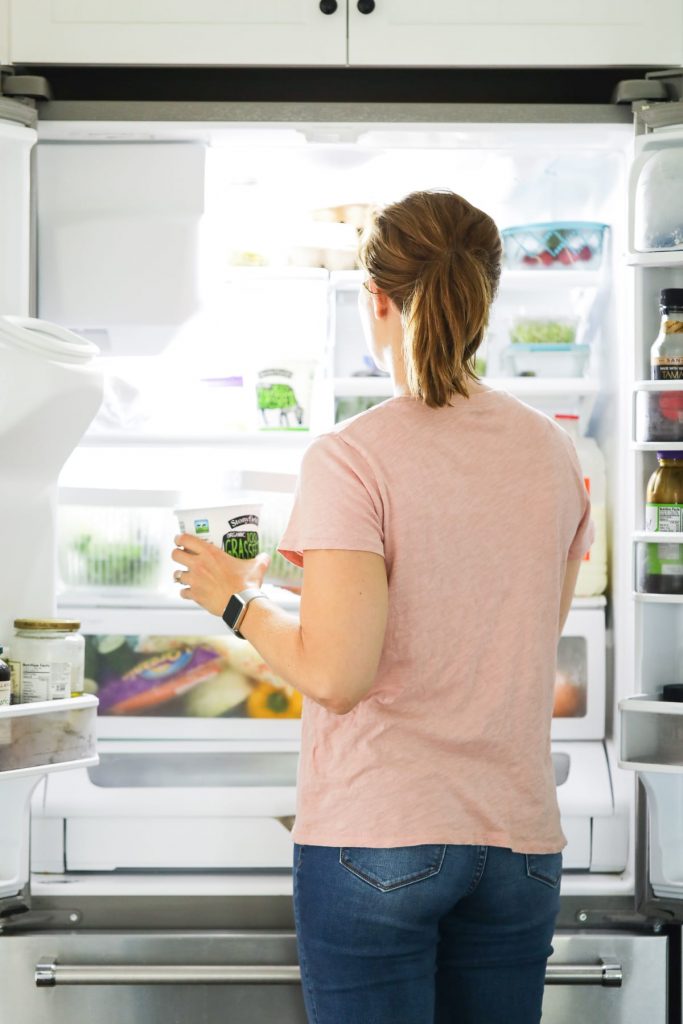How Can I Disinfect My Refrigerator Naturally?
The same rules apply to placing food in a filthy refrigerator as they do when using a dirty plate. A lot of people are grasping knobs and opening drawers, leaving food residue and meat drips on the surfaces, endangering your food.
Additionally, the contents of your fridge may begin to smell like rotting food. As a result, thoroughly cleaning and sanitizing your refrigerator will make it a safe space for food storage and aid in disease prevention.
Natural Disinfectant Spray Recipe
Here is the recipe:
- 1/2 cup Apple Cider Vinegar
- 1/2 cup Hydrogen Peroxide
- 1 cup Water
Mix in a spray bottle as a highly effective, non-toxic way to clean your refrigerator.
You can also add some essential oils to make it smell good and also increase its’ antibacterial properties.
- bergamot
- orange
- lemon
Step 1: Defrost (optional)
Unplug the refrigerator to begin defrosting it if you notice a lot of build-up on the sides.
If it doesn’t need defrosting, lower the temperature to prevent wasting energy while you clean it.
Put some ice and ice packs in coolers where you can store your food while cleaning the refrigerator.
You don’t want to put dirty food containers into your clean refrigerator. Therefore, as you pull out each item, inspect and clean them before putting them in coolers.
Any bottles and containers that are sticky or have drips on them should be wiped with a damp rag.
Throw away anything that smells bad, is going bad, or is past the “use by” date.
SEE MORE:Refrigeration: What Stays in and What Comes Out
Step 3: Wash Everything That is Removeable
Now that the fridge is empty of all food, remove as many shelves, drawers, and racks as possible. Wash them in the sink with hot water and dish detergent.
Many people recommend wiping down everything with bleach. However, bleach is a very harsh chemical that shouldn’t be put around your food. Therefore, after washing with soap and water in the sink, spray everything with your natural disinfectant spray, wipe it all down with a clean rag, and allow it to air dry.
ALSO:How and where to Keep Avocados Fresh for a Long Time in a Surprising Way
Step 4: Clean and Disinfect the Entire Refrigerator
Before you start wiping, make sure to use a vacuum or your hand to remove any crumbs.
Using your natural disinfectant spray, start wiping down the entire refrigerator.
Starting with the interior, spray in walls, doors, and interior parts. You could use an old toothbrush to get into creases and crevices. Then move on to the outside handles and flat surfaces.
Make sure to clean the area where the door seals with the fridge. This is often an area where mold and mildew form.
For stains or stuck-on food, you can mix baking soda and dish soap to form a paste. Scrub the paste on all difficult spots to help remove them. However, this can be abrasive and scratch the surface, so test it in an inconspicuous area first.
Once all difficult stands and build-up are removed, do one last wipe-down with your disinfectant spray.
Step 5: Put the Fridge Back Together
Allow your refrigerator to air dry. Once everything is dry, replace all shelves, drawers, and racks and plug the fridge back in or reset the temperature (depending on which way you decided to go). Close the doors and allow the fridge to get cold again.
The recommended temperature for your refrigerator is between 34 and 40 degrees, and the freezer should be between -10 and -20 degrees.
ALSO READ:4 Effective Recipes For Strengthening The Immune System
Step 6: Put All the Food Back
It could take up to two or three hours for your fridge to get back to a food-safe temperature again. To get the most accurate estimate of how much time it will take, refer to your refrigerator’s owner’s manual.
Replace the food once the refrigerator is cold enough.
You may also put an open box of baking soda in the back of your refrigerators to help avoid odors there. Baking soda eliminates smells!








.jpg)




